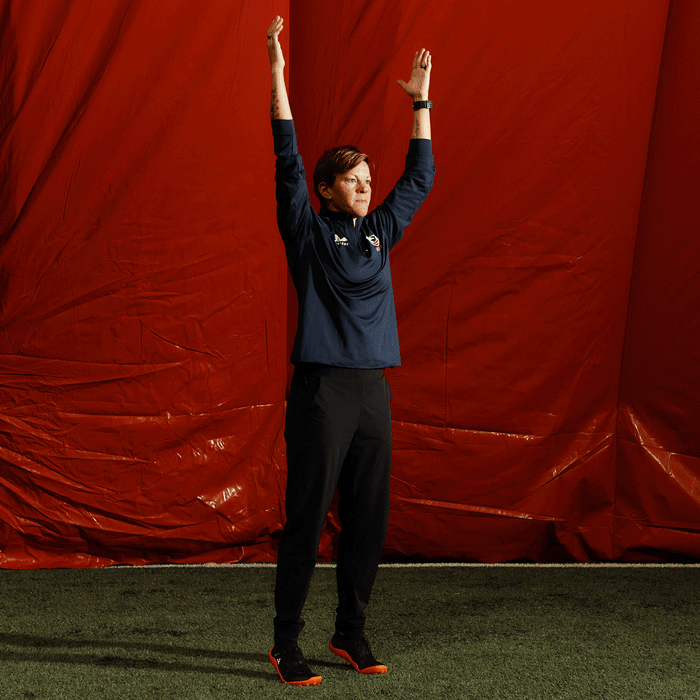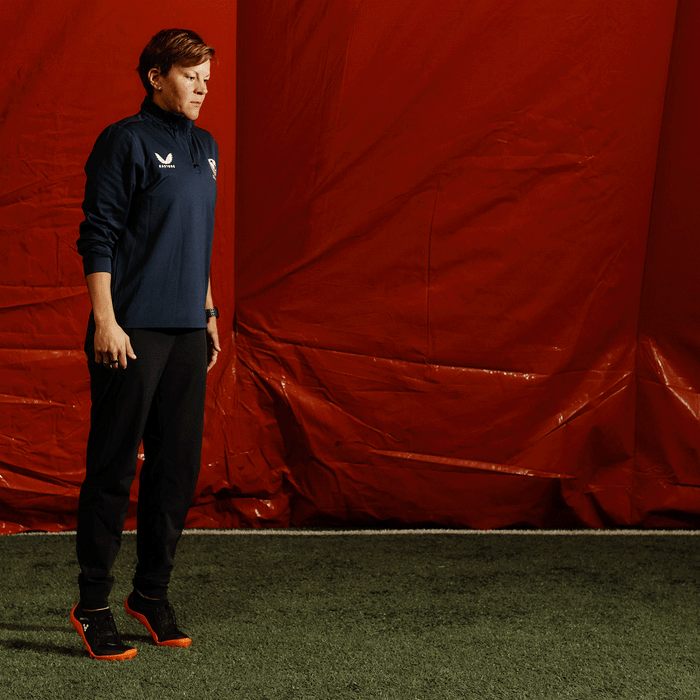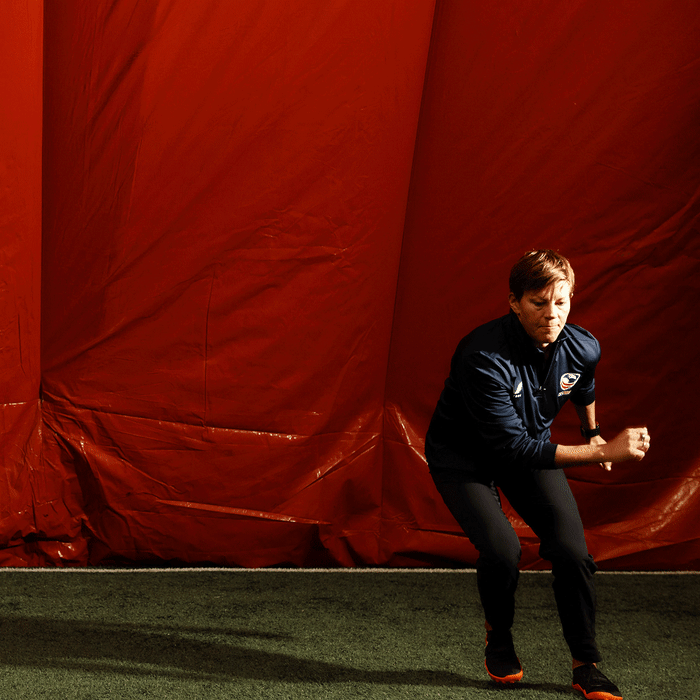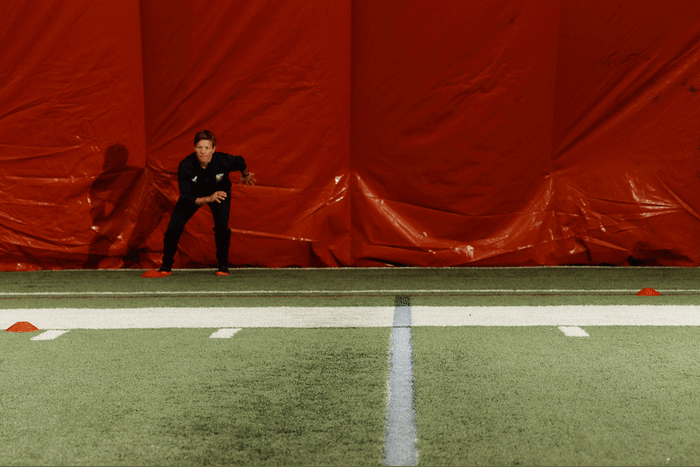We typically train to go faster. But mastering how to slow down and stop is just as important.
Training deceleration—a series of movements that help you slow down, change direction, or stop—teaches the body how to control and safely absorb forces. For athletes like rugby players and soccer players who are constantly accelerating from zero to 100 then stopping on a dime, proper deceleration enhances performance and is key to mitigating injury.
Being able to decelerate with control is just as valuable for nonathletes, says
Sylvia Braaten,
physical performance coach for USA Rugby women’s national team.
“As we age, there is a tendency to lose our coordination, athleticism and body control,” says Ms. Braaten, who also serves as the assistant coach for Harvard University’s women’s rugby team. “If you can’t slow down with proper body mechanics while chasing your grandchildren in the yard or playing a pickup basketball game, injuries are more likely to occur. But, if we continue to train these qualities, we can remain athletic and that can have a lasting impact on our overall quality of life.”
Being able to slow down to regain our balance is extremely helpful in the winter, when sidewalks and driveways are icy. “Improving coordination and deceleration mechanics can help us catch ourselves when we start to fall,” she says. And more than one out of four people ages 65 and older falls each year, according to the Centers for Disease Control and Prevention.
The following drills will reinforce deceleration mechanics, such as dropping the hips and shoulders as you slow down and keeping weight predominantly over the planted foot when you change direction. They are also a fun way to mix up your workout with multiplanar movements and balance and agility challenges, she says.
Start slow and focus on proper technique and landing in a controlled and stable position, she says. “It is better to perform fewer reps and sets with proper form.”
Reverse Eccentric Lunge
Why: Eccentric strength training, where the lowering phase of an exercise is slowed down to keep the muscles under tension for a longer period of time, is a great way to build strength, says Ms. Braaten. This lunge variation forces us to control the lowering motion while working the glutes and hamstrings.
How: Stand with your feet hip-width apart. Step your left foot backward and slowly lower your body for a count of 3 to 5 seconds, until the right thigh is parallel to the floor, knee over your shoe laces. Your torso and shin of the front leg should be parallel. Pause for 1 second then press into the heel of your front foot to come back up to the starting position for a count of 1 second. Perform 3 sets of 5 reps per leg. Rest 1 to 2 minutes per set.
Option: Hold weights for an added challenge.
Ms. Braaten performs a reverse eccentric lunge.
Drop Lunge Snap Down
Why: The additional speed component of this exercise increases the intensity of the lunge and more closely mimics the demands of movements in a rugby match and real life, she says.
How: Stand tall on your tiptoes with arms overhead. Rapidly drop into a reverse lunge with your front foot flat and on the ball of the back foot, with your heel raised. Use a quick and sharp arm drive down toward the floor to help increase the speed of the drop. “Think about transitioning from fast to freezing like a statue,” she says. Slowly rise to the starting position. Perform 2 to 3 sets of 3 reps per side. Rest 30 seconds between sets.
Options: If your balance is difficult, start on flat feet and progress to tip toes. Add weights for more difficulty.

Ms. Braaten does a drop lunge snap down.
Two-Step Falling Deceleration
Why: Being able to safely stop a fall is key to mitigating injury. This drill teaches the body to decelerate while building single-leg strength.
How: Stand tall, with feet hip-width apart. Begin to fall forward with a tall spine. Use two steps to stop. The first step is used to break and the second step is the stick or the leg to decelerate on. Landing on the full foot will help increase balance and allow for a quicker, more efficient deceleration. As you step to break, avoid any inward collapse of the knee. Perform 2 to 3 sets of 3 reps per side. Rest 30 to 45 seconds between sets.
Options: Have a friend stand in front of you as a spot or perform this exercise near a wall.

Ms. Braaten demonstrates how to perform a two-step falling deceleration.
Lateral Rebound Skater Jump
Why: Our body moves in different planes of motion. This drill trains single-leg deceleration in the frontal or side-to-side plane and improves our ability to absorb force.
How: Stand tall, balanced on your left foot. Sink your hips back to load your weight then push and powerfully jump off of that foot to the right. Swing the arms across the body for momentum as you jump. Land balanced on the right foot with a slight bend in the knees and hips.
“The emphasis should initially be on sticking the landing rather than on the distance of the jump,” she says. Reset for the next rep by hopping back to the left leg and repeating the movement. Perform 2 to 3 sets of 4 reps per side. Rest 30 to 45 seconds between sets.
Option: After you are able to consistently stick the landing, you can speed up the tempo to increase the difficulty and intensity for added cardio benefits.

Ms. Braaten does a lateral rebound skater jump.
Deceleration With a Half Turn
Why: This exercise trains agility, coordination and balance. Great for weekend warriors playing cutting sports like basketball or soccer, the deceleration-with-a-half-turn drill reinforces getting into good deceleration positions from a run, she says.
How: Jog forward and after 10 to 15 feet, decelerate by dropping your shoulders slightly to the right and over the inside of your hips. As your right foot plants, complete a half turn to the right. Stop in an athletic ready stance with soft knees and torso and shins parallel. Stick and hold the position before jogging forward 10 to 15 feet again and decelerate in half-turn position to face the left. Alternate half turns to each direction for a total of 3 half-turn decelerations on each side. Perform 3 to 4 sets. Rest 30 to 60 seconds between sets. Increase the pace of the jog to a run to progress.

Ms. Braaten demonstrates the deceleration-with-a-half-turn drill.
Zigzag Tempos
Why: After the above exercises helped strengthen your deceleration positions, this drill will help improve your ability to get in and out of those positions and make you more agile, she says.
How: Place 6 to 8 cones or markers each about 10 to 15 feet apart in a zigzag pattern to get in 3 to 4 decelerations per side. Start at one cone and run at a controlled pace to the next. Decelerate by bending into the knee and flexing at the hip of the planted foot while maintaining a tall spine. Push down into the planted leg to push away from the cone and run to the next one. Decelerate as you reach each cone. Keep the shoulders facing square up field through the entire drill. Try to become a statue at each cone before running to the next. As you increase speed you will need to absorb more force to decelerate efficiently. Perform 3 to 4 sets resting 30 to 60 seconds in between.

Ms. Braaten performs zigzag tempos.
SHARE YOUR THOUGHTS
How do you implement agility into your exercise routine? Join the conversation below.
Write to Jen Murphy at workout@wsj.com
Copyright ©2022 Dow Jones & Company, Inc. All Rights Reserved. 87990cbe856818d5eddac44c7b1cdeb8